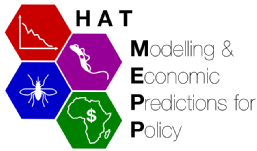HAT (gHAT or sleeping sickness)
 Gambiense Human African Trypanosomiasis (gHAT or sleeping sickness) is a tropical disease found in West and Central Africa, transmitted to humans by tsetse (biting flies), that is typically fatal without treatment. Success of medical "screen and treat" strategies to reducing sleeping sickness means that cases are at historically low levels and has lead to the World Health Organization setting two milestones for gHAT: (1) to achieve elimination as a public health problem by 2020, and (2) to achieve zero transmission by 2030.
Gambiense Human African Trypanosomiasis (gHAT or sleeping sickness) is a tropical disease found in West and Central Africa, transmitted to humans by tsetse (biting flies), that is typically fatal without treatment. Success of medical "screen and treat" strategies to reducing sleeping sickness means that cases are at historically low levels and has lead to the World Health Organization setting two milestones for gHAT: (1) to achieve elimination as a public health problem by 2020, and (2) to achieve zero transmission by 2030.
The team at Warwick are helping to support on-going gHAT interventions and global efforts to eliminate the disease through mathematical modelling under two research projects (see below), which combine the research expertise of mathematical modellers, health economists, epidemiologists and a software developer at the University of Warwick and Swiss TPH (see the team):
HAT Modelling and Economic Predictions for Policy
Neglected Tropical Disease (NTD) Modelling Consortium


